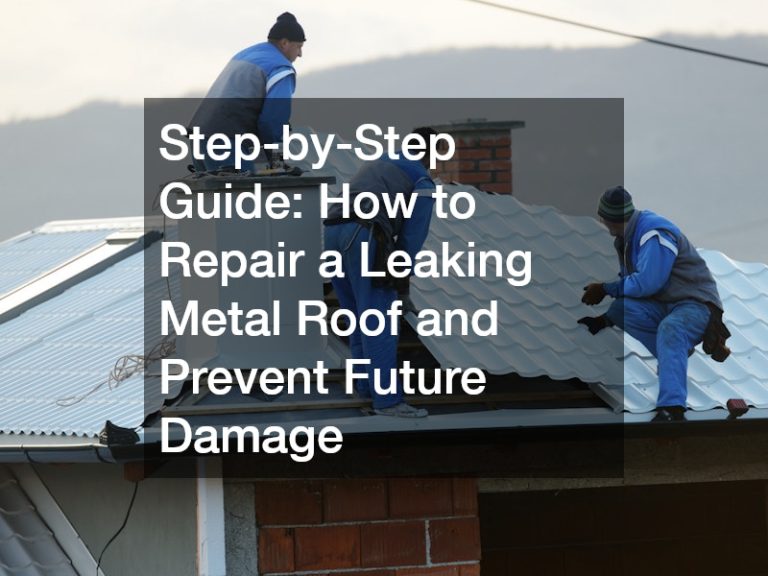How to Repair a Roof Valley and Strengthen Your Roof’s Integrity
Roof valleys, the junctions where two roof slopes meet, are among the most vulnerable parts of your roof. They funnel water and debris, making them prone to leaks and damage over time. A leaking roof valley can lead to significant problems such as water damage, mold growth, and even structural deterioration. To avoid these issues, it’s important to know how to repair a roof valley and ensure your roof remains strong and secure.
This guide will take you step-by-step through the process of repairing a roof valley, whether it’s made of metal, shingles, or another material. We will also touch upon preventative measures to stop future leaks. Additionally, we’ll incorporate helpful insights on how to repair a leaking metal roof in case your roof valley uses metal flashing.
Step 1: Identify the Cause of the Leak
Before repairing the roof valley, it’s essential to pinpoint the source of the problem. Roof valley leaks can occur due to several reasons:
- Debris buildup: Leaves, branches, and other debris can accumulate in roof valleys, blocking water flow and causing leaks.
- Damaged flashing: The metal flashing that protects the roof valley from water penetration can become corroded or damaged over time, especially in metal roofs.
- Worn or cracked shingles: Shingles in the roof valley may become loose, cracked, or worn due to age and exposure to weather elements.
- Improper installation: Incorrectly installed valley flashing or shingles can also lead to leaks.
To inspect the roof valley, look for signs of water pooling, loose or cracked shingles, or gaps between the flashing and roof surface. Use a garden hose to run water through the valley and see if any leaks occur inside your home.
Step 2: Clean and Clear the Roof Valley
Cleaning out debris is a crucial first step in repairing a roof valley. Over time, leaves, dirt, and branches can accumulate, obstructing the natural flow of water and contributing to leaks.
Here’s how you can clean the roof valley:
- Remove debris manually: Use gloves to remove leaves, twigs, and any other buildup by hand. Be gentle to avoid damaging the shingles or flashing.
- Check the flashing and shingles: While cleaning, inspect the metal flashing and shingles for any signs of damage or corrosion.
- Clear downspouts and gutters: Ensure that gutters and downspouts are also free of debris, as blocked gutters can lead to water overflow into the roof valley, worsening the leak.
Step 3: Repair or Replace Damaged Shingles
If you notice damaged shingles in the roof valley, you’ll need to repair or replace them. Here’s how:
- Remove the damaged shingles: Use a pry bar to carefully lift and remove the damaged shingles from the valley area. Take care not to damage the shingles around the valley.
- Install new shingles: Cut replacement shingles to fit the size of the valley and apply roofing cement to the back of each new shingle. Slide the shingle into place, ensuring it overlaps the valley properly.
- Seal the shingles: Use roofing nails to secure the new shingles in place. Apply a layer of roofing cement along the edges of the shingles to create a watertight seal.
If the shingles are not the root cause of the leak, the issue may be related to the valley flashing.
Step 4: Repair or Replace the Roof Valley Flashing
Roof valleys often contain metal flashing to prevent water from seeping through. If your roof valley uses metal flashing and you’re dealing with a leak, the flashing may be compromised.
To repair a roof valley with metal flashing:
- Inspect the flashing: Look for cracks, rust spots, or gaps between the flashing and the roof.
- Seal minor cracks: For small cracks or holes in the flashing, use a metal patching compound or roofing sealant to fill the damaged area.
- Replace damaged flashing: If the flashing is severely corroded or bent, it’s best to replace it. Carefully remove the old flashing and install a new piece of metal flashing, ensuring it fits snugly in the valley and overlaps both sides of the roof.
- Nail and seal the flashing: Secure the new flashing with roofing nails and apply a generous amount of roofing cement to create a waterproof seal along the edges.
For those with a metal roof, this step will be especially important, as valley flashing plays a critical role in preventing leaks. If you need detailed guidance on how to repair a leaking metal roof, you should follow similar steps to repair or replace the flashing. Metal roof valleys require careful sealing to prevent water from penetrating the roof structure.
Step 5: Apply Roofing Cement
Once you’ve repaired or replaced the shingles and flashing, it’s time to apply roofing cement. This acts as an extra barrier to prevent water from leaking through the roof valley.
- Apply cement in the valley: Using a trowel spread roofing cement along the length of the roof valley. Ensure it covers all seams between the shingles and the flashing.
- Smooth the cement: Use the trowel to smooth out the roofing cement, making sure it forms a uniform layer that will direct water flow away from the valley.
- Check for leaks: After the cement dries, test the roof valley by running water through it to see if any leaks occur.
Step 6: Prevent Future Leaks
Preventative measures are key to avoiding roof valley leaks in the future. Here’s what you can do to maintain the strength and integrity of your roof valley:
- Regular inspections: Inspect your roof valley every six months or after major storms to check for damage or debris buildup.
- Keep gutters clean: Ensure that gutters and downspouts remain clean and free of blockages to prevent water from pooling in the roof valley.
- Trim overhanging branches: Trees that hang over your roof can drop leaves and debris into the valley. Trim back these branches to reduce the chances of blockages.
- Check flashing and shingles: Pay close attention to the condition of your roof’s flashing and shingles. If you notice any damage or signs of wear, address the issue immediately to avoid future leaks.
Conclusion
Repairing a roof valley may seem daunting, but by following this step-by-step guide, you can protect your home from leaks and further damage. Whether you’re dealing with loose shingles or damaged flashing, timely repairs are essential to maintaining your roof’s structural integrity.
For those with metal roofs, it’s also important to understand how to repair a leaking metal roof as metal valley flashing is a common source of leaks. Regular maintenance, inspections, and proactive repairs will go a long way in preserving the health of your roof and preventing costly issues down the road. By keeping your roof valley in top condition, you can ensure your home stays dry, safe, and secure for years to come.

